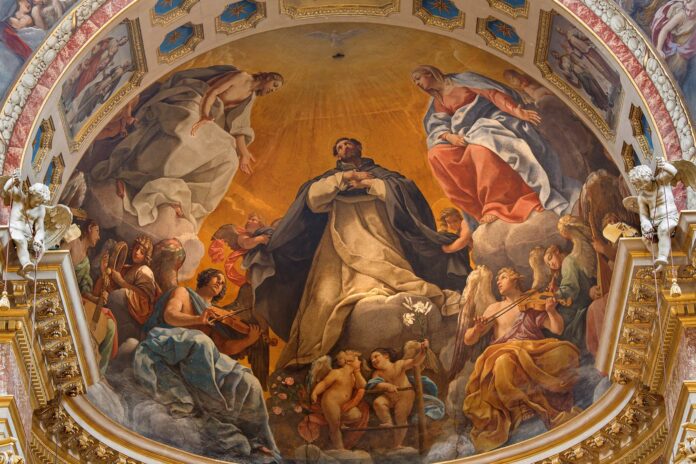
Saint Dominic (+1221) was one of those souls destined from birth to do great things – as, we may suppose, all saints are in some way. But all the contemporary accounts attest to his burning desire for God from the earliest age: His mother, Jane of Aza (eventually canonized by Pope Leo XII in 1828) had a prophecy during her pregnancy, of a dog with a flaming torch in its mouth setting the world ablaze. Some say the story was made up, a play on the name of the Dominicans – Domini canes, the ‘dogs of the Lord’. But like all legends, there is at least some truth to it: After all, her son did set the world on fire, and as Dominic’s later disciple, Saint Thomas, would later quip, he’d soon believe pigs could fly, than that a Dominican – or a Dominican’s mother – could lie.
Dominic, destined for the religious life, first joined the Augustinians, and was sent on a mission to convert the Cathars in southern France, a heretical sect that denied the goodness of God’s creation, including marriage and children, a mediaeval version of the early Manichees, who thought the noblest thing one could do was commit slow suicide by starvation. At the very least, and whatever else you do, do not procreate and trap more souls in bodies, condemning them to a life of misery.
What is old is new again.
It was a demonic doctrine, and the State tried to crush them by force, while the Church tried by eloquent preaching. But Dominic realized that the best way to convert them was to imitate their own lives of poverty and austerity, but not out of fear or loathing, but joy and love: To be cheerful paupers for Christ, loving all creation, even one’s enemies, yet at the same time highly educated, steeped in orthodoxy, and persuasive. Dominic had already spent ten years in university studies, and had adopted an ascetical life, with long hours in prayer and meditation.
So he founded an Order to do the work, calling them the Ordo Praedicatorum, the ‘Order of Preachers’, but commonly called the Dominicans, whose primary task is to contemplate, study and hand on the fruits of this work to those who ‘know not the truth’. I heard somewhere that in their Rule, Dominicans are supposed to study four hours a day; I hope that is still true, both in theory and in practice, for God’s people still perish for lack of truth, as the prophet Hosea lamented – now perhaps more than ever. Yet prayer is their primary weapon, not least the Rosary of Our Lady, devotion to which Dominic helped to propagate. The Virgin Mary is an ally whom no heretic nor demon can withstand.
Dominic was more clear in his purpose and vision than his contemporary Francis, who was always ambivalent about beginning an Order. For how does one build an organization on the principles of a man whose very mission was to own nothing? Hence, the persistent fissiparity of the followers of Francis; they would be the largest Order in the Church, if there not so many branches and types of them, all seeking to return to that ideal of their founder. Much to the good, and there have been countless saints, missionaries and martyrs amongst the Franciscans.
Yet, from the beginning, Dominic was clear that he wanted an Order of scholarly priests, firm and resolved in their work and purpose, first, against the Cathars, but, seeing their value, the Church soon used the Dominicans as agents against all heresies, and as preachers and teachers of the full, unbounded clarity of orthodoxy. It is a war, but a joyful one, whose mission is not to destroy the enemy, but lead him to paradise.
Dominic taught the goodness of the things of this world, and he attested to this goodness, ironically, by giving them up for God, going barefoot, never using a bed, abstaining from meat, an ascetical life, combined with strict chastity and purity, but always praising the Almighty for all He had given, as his spiritual son, Thomas Aquinas, born four years after the death of the founder, would do even more clearly and systematically, and his writings – not least the synthesis of Thomas’ quasi-miraculous Summa – stand as a testament to what Dominic began.
After a life of praying, penance and preaching, his body worn out, Dominic died on August 6th, 1221, at the age of 51, at the convent of Saint Nicholas in Bologna, but not before seeing his Order approved by Pope Honorius III in 1216. He was canonized by Pope Gregory IX in 1234. His relics reside at the church of Saint Dominic in Bologna.
Pray to Dominic and Thomas today for a return to that clarity of vision, the truth of all creation in all its depth and wonder.
Praise God, for we are fearfully and wonderfully made.
Saint Dominic, ora pro nobis!










